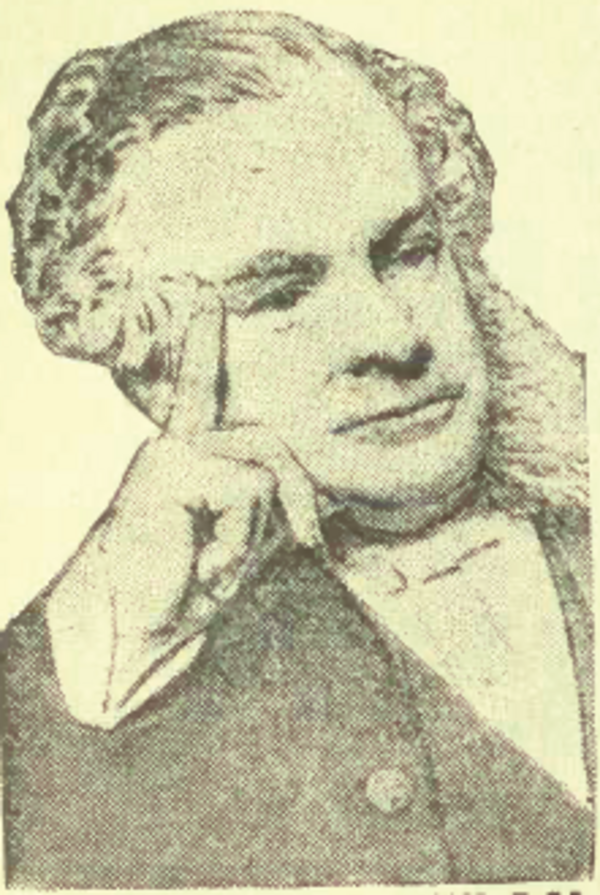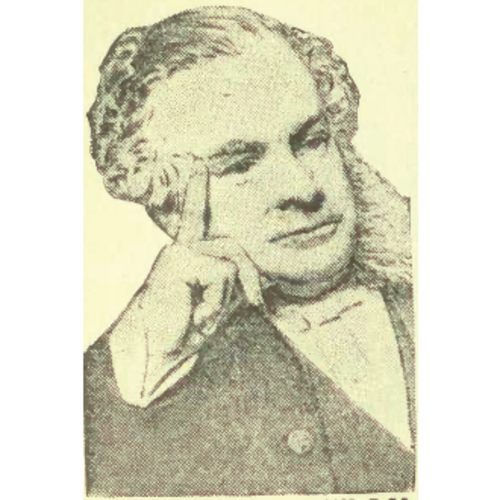
Source: Courtesy of Wikimedia Commons
HARMAN, SAMUEL BICKERTON, lawyer, accountant, politician, and civil servant; b. 20 Dec. 1819 in Brompton (London), England, son of Samuel Harman, West Indian planter and office holder, and Dorothy Bruce Murray; m. 26 July 1842 Georgiana Huson, and they had six sons and two daughters; d. 26 March 1892 in Toronto.
Samuel Bickerton Harman attended King’s College School in London. He started his career as a clerk with the Colonial Bank’s office in Barbados in 1840. Two years later, in Toronto, he married a daughter of George Huson, a Barbadian planter. Harman’s uncle Davidson Munro Murray, who had married another daughter of Huson’s, had settled in Toronto about 1835 and the Huson family had financial interests there. The Harmans’ first child, Samuel Bruce, was born in 1843 in Grenada, where Harman had moved to be the accountant and eventually the manager of the Colonial Bank’s branch.
Harman went back to England in 1847, apparently on family business. The next year he came with his wife and four sons to Canada to retrieve a Huson family investment which was in trouble. Whatever the nature of that investment, the result of Harman’s rescue attempt was probably not satisfactory, for though Harman lived in a fashionable part of Toronto, he was forced to resume working for a living. By the early 1850s he was reading law with John Hillyard Cameron*. He got his bcl from Trinity College, Toronto, in 1855 by examination. Later that year he was called to the bar and began practising as Cameron’s junior partner. He would be with Cameron for 17 years as a law clerk and a partner. Huson William Munro Murray, a nephew of Georgiana Harman and a son of Davidson Munro Murray, was also associated with the firm. Harman worked in the field of commercial law and, because of his good training in accounting, he specialized in complicated arbitration matters. In 1869 he was appointed a bencher of the Law Society of Upper Canada but in 1871, when the general membership got the vote, he failed of election, dismally.
From the time he entered law, Harman busied himself with others of the local élite in various activities. An Anglican, he participated in the ill-fated Church of England and Metropolitan Building Society in 1851. He was a member of the first diocesan synod in 1853, treasurer of the diocese during 1856–58, and its registrar from 1859 to 1877. He did much legal work for the corporation of Trinity College, doubtless as a result of Cameron’s connection with its law faculty. In 1852 he helped to establish the Toronto Boat Club (later the Royal Canadian Yacht Club). He rose through the executive of the St George’s Society to become president in 1860, the year the Prince of Wales visited. A master freemason from 1842, he introduced the Knights Templars into Toronto in 1854 and remained active in that order as a senior officer until 1882. Between 1850 and 1853 the Harmans had three more children. The last child, Georgina Mary, was born in 1856 and died later that year.
In 1866 Harman entered municipal politics as an alderman for St Andrew’s Ward, which he represented until 1872. He was elected mayor for 1869 and again for 1870. With his associates, including former mayor James Edward Smith, he changed the civic administration of Toronto from a casual, part-time activity to a professionally managed municipal government. Harman himself had chaired the commission which produced the first consolidation of the city’s by-laws, in 1868. In the early 1870s the progressive group on council was concerned about gross inadequacies in Toronto’s assessment procedures. Accordingly, to achieve the necessary improvements, Harman was appointed assessment commissioner in November 1872 at an annual salary of $3,000, making him the highest paid civil servant the city had ever had. (Mayor Joseph Sheard, by comparison, received $4,000 that year.)
As commissioner Harman demonstrated his organizational and administrative skills to great advantage. He found evaluators, got them trained, and designed and implemented procedures for consistent valuation in time to reassess the entire city for the 1873 tax roll. The results were staggering: the assessable tax base rose from $32 million the previous year to $44 million, an increase that substantially augmented revenue even after the tax rate had been sharply cut. It cannot be proved but Harman must have participated in the manœuvre in 1874 that forced Andrew Taylor McCord* out of the treasurer’s office, which he had occupied for 40 years. Harman applied for and won the position.
Harman’s superb political skills may be best illustrated in his organization of the Institute of Chartered Accountants of Ontario. Formed in 1879, it began an initially futile chase after provincial incorporation. In February 1882 the institute’s council, knowing it needed help, recruited Harman as president. In the space of a year he revamped the council to make it politically important, enlarged and to some extent inflated the membership, stage-managed a public meeting of Toronto’s business élite that demanded incorporation, lobbied Toronto’s mpps and the appropriate cabinet ministers, and retained the best legal talent. The result was incorporation in February 1883.
Though he had come from a background of wealth, in the sugar estates of Antigua and the country home in England, money was a problem for Harman from the time of his arrival in Canada. All through his life in Toronto the family lived in rented quarters. In April 1862 Bishop John Strachan* wrote on Harman’s behalf to Sir Allan Napier MacNab*, then a member of the Legislative Council, seeking an appointment for him as clerk of the county court. In 1870 Samuel Bruce Harman, then on his way to the Red River rebellion as a captain in the 2nd Battalion, Queen’s Own Rifles, wrote to his mother, “I will try next month and send you a cheque for $60.00 which might help you a little in Papa’s absence.” Bruce was concerned that she needed assistance in nursing his younger brother Lloyd Cusack Athill Murray, who suffered from some wasting sickness. The mid 1870s were a period of loss for the Harman household: the remaining daughter died in 1874 and Lloyd succumbed the next year. Six years later another son died.
Despite such personal hardship, Harman was quite capable of reorganizing the city treasurer’s department, where he introduced new methods and procedures. He attracted competent staff, including Richard Theodore Coady, his assistant, and John H. Menzies, both of whom were active in the councils of the Institute of Chartered Accountants of Ontario. But the city continued to grow rapidly, an expansion that resulted in a vastly increased work-load for Harman’s department. Some time in the mid 1880s he became ill and was unable to cope. One may speculate that the situation was exacerbated by his unwillingness to delegate. Harman nevertheless hung on to the treasurership because he needed the salary. Eventually, after a confrontation with the city’s executive committee in the fall of 1888, he was forced to resign, but he did receive a splendid annual pension of $2,000, the biggest the city had ever paid.
Harman summed up his life in his official letter of resignation, “It is not too much to say that civic life had become a second nature, the severance of myself from which was no easy matter.” He lingered on at his home, but in the early 1890s he declined rapidly and he died on 26 March 1892. Perhaps he had persisted in the spending habits of well-to-do planters, for he left to his heirs an estate worth less than $1,465.
CTA, D. M. Harman, “Biographical memoirs of Samuel Bickerton Harman and the Harman family in Canada, 1849–1938” (typescript). St Mary Abbots Church (London), Reg. of baptisms for the parish of Kensington, 1 Feb. 1820. York County Surrogate Court (Toronto), no.9061 (mfm. at AO). Globe, 28 March 1892. Monetary Times, 1 April 1892. Chadwick, Ontarian families. Roll of U.C. College (A. H. Young). Philip Creighton, A sum of yesterdays: being a history of the first one hundred years of the Institute of Chartered Accountants of Ontario (Toronto, 1984). Robertson’s landmarks of Toronto, 3: 480. V. L. Russell, Mayors of Toronto (1v. to date, Erin, Ont., 1982– ).
Cite This Article
Philip Creighton, “HARMAN, SAMUEL BICKERTON,” in Dictionary of Canadian Biography, vol. 12, University of Toronto/Université Laval, 2003–, accessed April 28, 2025, https://www.biographi.ca/en/bio/harman_samuel_bickerton_12E.html.
The citation above shows the format for footnotes and endnotes according to the Chicago manual of style (16th edition). Information to be used in other citation formats:
| Permalink: | https://www.biographi.ca/en/bio/harman_samuel_bickerton_12E.html |
| Author of Article: | Philip Creighton |
| Title of Article: | HARMAN, SAMUEL BICKERTON |
| Publication Name: | Dictionary of Canadian Biography, vol. 12 |
| Publisher: | University of Toronto/Université Laval |
| Year of revision: | 1990 |
| Access Date: | April 28, 2025 |



